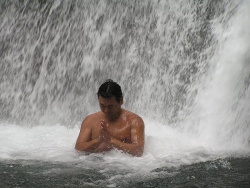Difference between revisions of "Five false views"
m (Text replace - "1" to "1") |
|||
| Line 1: | Line 1: | ||
[[File:Taki-gyo 8118084.jpg|thumb|250px|]] | [[File:Taki-gyo 8118084.jpg|thumb|250px|]] | ||
<poem> | <poem> | ||
| − | + | [[five false views]] | |
| − | [五利使] (Jpn go-rishi ) | + | [[五利使]] (Jpn [[go-rishi]] ) |
According to The Treatise on the Establishment of the [[Consciousness-Only]] [[Doctrine]], the five [[views]] that, along with the [[five delusive inclinations]], constitute the ten fundamental [[earthly]] [[desires]]. [[T'ient'ai]] (538-597) included these ten in the [[illusions]] of [[thought]] and [[desire]], the first of the three categories of {{Wiki|illusion}}. | According to The Treatise on the Establishment of the [[Consciousness-Only]] [[Doctrine]], the five [[views]] that, along with the [[five delusive inclinations]], constitute the ten fundamental [[earthly]] [[desires]]. [[T'ient'ai]] (538-597) included these ten in the [[illusions]] of [[thought]] and [[desire]], the first of the three categories of {{Wiki|illusion}}. | ||
| Line 8: | Line 8: | ||
The [[five false views]] are: | The [[five false views]] are: | ||
| − | (1) Though the [[mind]] and {{Wiki|body}} are no more than a temporary union of the [[five components]], one regards them as possessing a {{Wiki|self}} that is [[absolute]]; and though [[nothing]] in the {{Wiki|universe}} can belong to an {{Wiki|individual}}, one [[views]] one's [[mind]] and {{Wiki|body}} as one's own possession; | + | (1) Though the [[mind]] and {{Wiki|body}} are no more than a {{Wiki|temporary}} union of the [[five components]], one regards them as possessing a {{Wiki|self}} that is [[absolute]]; and though [[nothing]] in the {{Wiki|universe}} can belong to an {{Wiki|individual}}, one [[views]] one's [[mind]] and {{Wiki|body}} as one's own possession; |
(2) the [[belief]] in one of [[two extremes]] concerning {{Wiki|existence}}: that [[life]] ends with [[death]], or that {{Wiki|life}} persists after {{Wiki|death}} in some {{Wiki|eternal}} and [[unchanging]] {{Wiki|form}}; | (2) the [[belief]] in one of [[two extremes]] concerning {{Wiki|existence}}: that [[life]] ends with [[death]], or that {{Wiki|life}} persists after {{Wiki|death}} in some {{Wiki|eternal}} and [[unchanging]] {{Wiki|form}}; | ||
| Line 14: | Line 14: | ||
(3) denial of the [[law of cause and effect]]; | (3) denial of the [[law of cause and effect]]; | ||
| − | (4) adhering to misconceptions and viewing them as {{Wiki|truth}}, while regarding inferior [[views]] as superior; and | + | (4) adhering to misconceptions and viewing them as {{Wiki|truth}}, while regarding {{Wiki|inferior}} [[views]] as {{Wiki|superior}}; and |
(5) viewing erroneous practices or [[precepts]] as the correct way to {{Wiki|enlightenment}}. | (5) viewing erroneous practices or [[precepts]] as the correct way to {{Wiki|enlightenment}}. | ||
Revision as of 14:53, 27 September 2013
five false views
五利使 (Jpn go-rishi )
According to The Treatise on the Establishment of the Consciousness-Only Doctrine, the five views that, along with the five delusive inclinations, constitute the ten fundamental earthly desires. T'ient'ai (538-597) included these ten in the illusions of thought and desire, the first of the three categories of illusion.
The five false views are:
(1) Though the mind and body are no more than a temporary union of the five components, one regards them as possessing a self that is absolute; and though nothing in the universe can belong to an individual, one views one's mind and body as one's own possession;
(2) the belief in one of two extremes concerning existence: that life ends with death, or that life persists after death in some eternal and unchanging form;
(3) denial of the law of cause and effect;
(4) adhering to misconceptions and viewing them as truth, while regarding inferior views as superior; and
(5) viewing erroneous practices or precepts as the correct way to enlightenment.
See also earthly desires.
